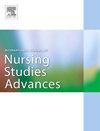COVID-19大流行导致轮班模式的变化:斯德哥尔摩医院重症监护护理人员的前瞻性队列研究
IF 3.1
Q1 NURSING
International Journal of Nursing Studies Advances
Pub Date : 2025-08-12
DOI:10.1016/j.ijnsa.2025.100408
引用次数: 0
摘要
众所周知,2019冠状病毒病大流行给医疗保健带来了压力,导致对重症监护病房(ICU)护理人员的工作需求增加,工作时间可能也更长。研究ICU护理人员轮班模式的潜在变化是很重要的,因为许多研究共同表明,某些轮班模式,特别是夜班,会增加护理人员患各种疾病的风险,如糖尿病、心血管疾病和早产。目的调查大流行期间(2020年3月1日至2022年5月31日)斯德哥尔摩公立医院ICU护理人员轮班模式的潜在变化,为危机规划提供信息。具体来说,我们调查了白班、晚班、夜班和长班的数量变化;夜班和晚班的快速返回;以及各疫情高峰对应的月平均工时。研究对象:2017年1月1日至2022年5月31日期间在ICU工作的护理人员,即护士、专科护士和助理护士(n = 1208)。方法数据来自斯德哥尔摩地区的计算机化行政雇员登记簿,其中包括工作时间的详细信息。中断时间序列回归采用三次中断建模,每次中断一次代表COVID-19患者流入高峰,用于调查COVID-19是否对班次模式产生影响。结果新冠肺炎疫情第一次高峰出现后,夜班人数立即增加673.15个(95%可信区间(CI): 487.25 ~ 859.04),夜班快速返回人数增加443.44个(CI 265.03 ~ 621.85),夜班连续≥3个(CI 116.57 ~ 286.46)。在第一个高峰之后,夜班的数量和夜班的快速回报都下降了。在高峰2,夜班人数和夜班快速返回分别增加了450.01 (CI 285.85-614.18)和397.45 (CI 220.43-574.46)。在第三个高峰时,连续工作日数立即减少。然而,从第二个月开始,夜班的人数和夜班的快速返回在统计上都有显著的上升趋势。结论2019冠状病毒病大流行期间,ICU护理人员夜班数量增加,夜班返回速度快。这些类型的轮班可能导致不利的健康影响,应尽量减少。医疗机构应在紧张时期为轮班时间表做好准备,以防止危险轮班的增加。研究注册:未注册本文章由计算机程序翻译,如有差异,请以英文原文为准。
Changes in shift patterns due to the COVID-19 pandemic: a prospective cohort study of the intensive care nursing staff in hospitals in Stockholm
Background
It is well known that the COVID-19 pandemic placed pressure on healthcare, leading to increased job demands for intensive care unit (ICU) nursing staff and possibly also longer working hours. Potential changes in shift patterns for ICU nursing staff are important to study as numerous studies collectively indicate that certain shift patterns, especially night shifts, increase the risk of developing various diseases, such as diabetes, cardiovascular diseases, and preterm birth among nursing staff.
Objective
To inform crisis planning, the aim was to investigate potential changes in shift patterns among ICU nursing staff working in public hospitals in Stockholm during the pandemic (March 1, 2020-May 31, 2022). Specifically, we investigated changes in the number of day, evening, night, and long shifts; quick returns from evening and night shifts; and mean monthly work hours corresponding to each peak of COVID-19.
Design
A prospective cohort study
Setting
ICU in four public hospitals in Stockholm
Participants
Nursing staff, i.e., nurses, specialist nurses, and assistant nurses working in the ICU (n = 1208) between 1 January 2017 and 31 May 2022.
Method
Data were obtained from a computerised administrative employee register in Region Stockholm, which includes detailed information on hours worked. Interrupted time series regressions, modelled with three interruptions, one for each peak of COVID-19 patient influx, were used to investigate whether COVID-19 had an impact on shift patterns.
Results
Results showed that the first peak of COVID-19 led to an immediate increase in the number of night shifts by 673.15 shifts (95 % confidence interval (CI): 487.25–859.04), quick returns from night shifts by 443.44 (CI 265.03–621.85) and ≥3 consecutive night shifts by 201.51 (CI 116.57–286.46). Following the first peak, both the number of night shifts and quick returns from night shifts declined. At peak two, the number of night shifts and quick return from night shifts increased by 450.01 (CI 285.85–614.18) and 397.45 (CI 220.43–574.46), respectively. At the third peak, there was an immediate decrease in the number of working days in a row. However, from the second month, a statistically significant upward trend was observed in both the number of night shifts and quick return from night shifts.
Conclusions
During the COVID-19 pandemic, (ICU nursing staff experienced an increase in both the number of night shifts and quick returns from night shifts. These types of shifts may lead to adverse health effects and should be minimised. Healthcare organisations should prepare for shift schedules during times of strain to prevent an increase in hazardous shifts.
Study registration
Not registered
求助全文
通过发布文献求助,成功后即可免费获取论文全文。
去求助
来源期刊

International Journal of Nursing Studies Advances
Nursing-General Nursing
CiteScore
5.80
自引率
0.00%
发文量
45
审稿时长
81 days
 求助内容:
求助内容: 应助结果提醒方式:
应助结果提醒方式:


